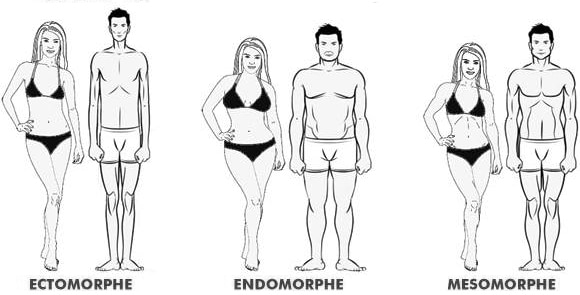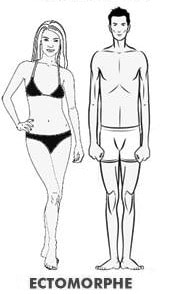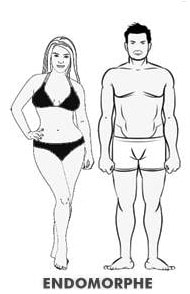[Article updated on 19/09/2023]
William H. Sheldon introduced the concept of the body shape in the 1940s. Since then, nutritionists, physiologists, and even doctors have used it to develop individualized fitness plans. Some say that knowing which body type you are closest to will help you better tailor your diet and exercise program to your needs and set realistic, achievable goals that pave the way to success. What exactly is it? Is categorization by morphotype a myth or a reality?
What is a morphotype?
Morphotypes are a taxonomy developed in the 1940s by American psychologist William Herbert Sheldon to classify the human physique based on the relative contribution of three fundamental elements he called “somatotypes”.
He named them after the three layers of the embryo: the endoderm (which diverts the digestive tract), the mesoderm (which gives rise to muscles, heart and blood vessels) and the ectoderm (which forms the skin and nervous system).
Its initial visual methodology was considered subjective and widely discredited, but variations, subsequently developed, are still used for academic purposes.

What is the origin of morphotypes?
Everything starts from one observation: humans have varied morphologies and personalities. Is there a cause and effect relationship between these aspects? The question remained without a real answer for a long time. However, history records that it is since Antiquity that observers have sought to find the links that could exist between morphology and personality. For example, Caesar said to Brutus: “Your speech is written on your forehead”.
Over the years, several types of categorization of the human body have been developed. In Ayurvedic medicine, which evolved from 5,000-year-old Sanskrit teachings, body types and associated personalities have been defined as Vata, Pitta and Kapha.
In the Western world, the first generation of these categorizations is called physiogromy and carried by Lavater (1741-1801) author of “Essais physiogronomiques”. He will be followed by several other contributors. The second generation is that of “functional typologies” treated by De Giovani, Pende and Viola (in Italy), Ernst Kretschmer (in Germany), Claude Sigaud and Paul Carton among others (in France) and Sheldon (in the United States).
American physician and psychologist William H. Sheldon introduced the theory of somatypes in the 1940s. His basic theory is that there are basically three morphotypes (body types). Each morphotype has a specific personality associated with it. Theories thus presented have become a central part of the literature and research on weight loss, exercise and strength training.
The morphotype system introduced by Sheldon characterizes the human body as being ectomorph, mesomorph or endomorph. Not all human beings fit exactly into one of these categories, but have characteristics specific to each of them.
What is the ectomorph morphotype?

People with the ectomorph body type have a well-sculpted body, most often seen in fashion magazines. These people have thin bones and long limbs. They are flexible and have very little body fat, as well as little muscle.
Individuals belonging to this somatype have low body fat levels, without having to exercise or follow a low-calorie diet. They can eat whatever they want without gaining weight. They have a fast and efficient metabolism, as well as difficulty gaining weight. Ectomorphic people are hyperactive and have difficulty gaining muscle mass. Models, ballerinas and basketball players generally belong to this group.
Although ectomorphic people tend to be well-liked, we must not forget that they have their own problems. They tend to be out of shape due to their low muscle mass. Males struggle to increase muscle mass and may appear stiff. Females generally have a breast flat and may complain of looking masculine. These people have to work very hard to achieve their goals.
As they age, ectomorphs’ lightning-fast metabolism slows down, and as a result, they sometimes gain weight, if they are not accustomed to exercising and watching their calorie intake.
What is the mesomorph morphotype?

According to Sheldon, people with a mesomorphic body type tend to have an average size. They can build muscle easily and have little fat. They are generally strong and solid, without excess weight. Their bodies are rectangular in shape with an upright posture.
Other features include a square-shaped head, chest and muscular shoulders, muscular arms and legs and even weight distribution. Mesomorphs may have no trouble eating whatever they want because they can easily lose weight. Those trying to stay slim may view this body type as a disadvantage.
Mesomorphs could be considered genetically favored people. They are characterized by an athletic, strong, compact and naturally lean body. They have excellent posture. Often their shoulders are wider than their hips and women tend to have an hourglass figure.
Mesomorphs are born athletes and tend to be lean and muscular without exercise. They are generally described as being of average build. The best tennis players, skaters and bodybuilders are part of this group.
What is the endomorph morphotype?

Endomorphs have a curvilinear physique and exhibit the opposite characteristics of ectomorphs. They have a slow metabolism, gain weight easily and have to work hard to lose body fat.
Endomorphs most often have a larger build and have hips wider than their shoulders, which gives them a pear-shaped physique. Some of the sexiest and most beautiful singers and actresses are endomorphs. Likewise, many actors and action heroes on the big screen are endomorphs.
As other characteristics, endomorphs have smooth, round bodies, medium to large joints and bones, small shoulders, short limbs, and high levels of body fat. This body fat tends to be deposited in the lower regions of the body, mainly the lower abdomen, buttocks, hips and thighs.
Endomorphs have a higher percentage of body fat with less muscle mass. They are very often heavier, but not necessarily obese. Due to their physical makeup, people with endomorphic bodies are more sensitive to calorie consumption.
Endomorphs need to closely monitor their food intake to ensure that they are not consuming more calories than they burn. Other characteristics include a larger frame and difficulty losing weight.
Does body type influence weight loss?
Your somatype greatly influences your ability to lose weight. Depending on which category you belong to, you can easily or very difficultly get rid of your excess pounds.
When it comes to weight loss, ectomorphs are nature’s darlings. These people are naturally slim and lean and do not need to exert intense effort to stay that way. They may gorge themselves on calories and fat, but they will always remain slender. They therefore do not need to monitor their figure all day long.
Mesomorphs are rather ambivalent. They lose and gain weight very easily. Naturally muscular and athletic, they have little body fat and have less need to lose weight. When they want to lose weight, they do it very easily, because their body and mind lend themselves easily to it.
On the other hand, endomorphs are very handicapped when it comes to weight loss. These people gain weight easily, but it is very difficult for them to lose it. Their mind and body put up resistance when the time comes to shed excess pounds. They sometimes have to exert superhuman efforts to obtain even modest results. These people must monitor what they eat on a daily basis if they do not want to be overweight.

What is the influence of body type on bodybuilding?
To build muscle effectively, it is essential to take your somatype into account. Each of the three physique categories has its own requirements when it comes to strength training and mass gain. By taking these differences into account, optimal results can be achieved.
Ectomorphs
Ectomorphs are efficient at turning carbohydrates into energy and their fast metabolism means they burn fat easily. The downside is that they have difficulty gaining muscle because their muscle fibers are underdeveloped.
To become more muscular, they should minimize cardio sessions and focus on intense workouts using compound exercises to maximize the release of growth hormone. They also need to take in about 3,000 calories per day, including plenty of starchy carbohydrates and whey protein, possibly in the form of supplements.
Mesomorphs
Mesomorphs have the body type that is best suited for gaining muscle and they don’t tend to store a lot of body fat. They tend to take their naturally athletic shapes for granted, which can lead to diluted workouts and poor nutrition.
Maintaining optimal fitness is often tempered by a scattershot approach to diet and training. The important thing is to make the most of your body shape. This means following a progressive plan that will make you stronger and more athletic by increasing your power without getting too bulky.
To fuel your workouts, you’ll need around 2,500 calories per day. You should eat plenty of whole grains, while limiting your total fat intake. You can indulge in exercises like sprinting, high jumping and boxing.
Endomorphs
The endomorph is the most difficult body type to deal with in terms of weight management and fitness. To achieve a more balanced physique, you should focus on developing the shoulders and eliminating excess fat from the lower body.
A low- to medium-intensity cardio program will help you shed fat, as will a 1,750-calorie-per-day, high-fiber diet. Although aerobic exercises are recommended by experts, weight lifting training is preferable because it burns calories long after the last exercise. The ideal would be to follow four days per week of hypertrophy training (lifting heavy weight with a low repetition rate).

What diet for your body type?
Since fitness types depend on your frame size and your natural propensity to be more muscular or store more fat, you cannot change your body type by following a particular diet. However, you can change your eating habits to get the most out of your body type and maintain a healthy weight.
Diet for ectomorphs
Ectomorphs have fast metabolisms, which is both a blessing and a curse. A high metabolism makes it easy to lose weight and it seems like they can eat whatever they want and not gain weight. However, as they age, their metabolism will slow down, mainly due to low muscle mass, which can lead to unhealthy body fat gain.
The best diet for an ectomorph is one that contains more carbohydrates and calories. About 50 to 60 percent of calories should come from carbohydrates, 25 percent from protein, and 25 percent from fat.
Eat every two to four hours. Add at least 500 calories if you want to gain weight or muscle. Choose warm foods rather than cold foods (better for digestion). The best starchy carbs include oats, brown rice, quinoa, sweet potatoes, and potatoes.
Best fruit choices include bananas, mangoes, pineapple, papaya, avocado and peaches. The best vegetable choices include broccoli, cauliflower, Brussels sprouts, beets and carrots, especially cooked in coconut oil or ghee (clarified butter). Ideal snacks include nuts and seeds, as well as nut butters.
The key is to always eat a healthy, balanced diet that is rich in nutrients. Just because you have an ectomorph body type doesn’t mean you should use it as an excuse to eat everything, including junk food.

Diet for endomorphs
If you have an endomorphic body and want to lose weight or gain muscle definition, you may want to consider a fitness plan and diet tailored to your body type.
According to diet theory, endomorphs have a slower metabolism. Since you don’t burn calories as quickly as ectomorphs and mesomorphs, excess calories are more likely to convert to fat.
Some believe that endomorphs are less tolerant of carbohydrates. The best diet for your body type may therefore consist of a higher protein and fat intake and a lower carbohydrate intake, such as the paleo diet. This diet can help you lose body fat while maintaining your energy levels.
Good sources of fat and protein include macadamia nuts, olive oil, beef, egg yolk, fatty fish, walnuts and cheese.
You don’t have to avoid carbs. Carbohydrates are an excellent source of energy. Removing carbs from your diet can trigger chronic fatigue. If too extreme, a low-carb diet can also lead to gastrointestinal issues and ketosis.
The trick is choosing the right type of carbs. Focus on complex carbohydrates such as vegetables, as well as starchy foods such as potatoes and tubers, legumes, whole grains and fruits.
Limit your intake of simple carbohydrates. These foods are high in calories, which can lead to fat storage. Simple carbohydrates include white pasta, cakes, cookies, bread and rice. Your diet should consist of 30% carbohydrates, 35% protein and 35% fat
Portion control is also important when reducing body fat as an endomorph. This helps you avoid excessive calorie consumption. Eating 200 to 500 calories less than you consume will also help you achieve your weight loss goal.

Diet for mesomorphs
Remember that mesomorphs can gain and lose weight easily. Since they have higher muscle mass, they may need more calories than other body types, but it’s a delicate balance.
Mesomorphs may perform better on diets high in protein and less focused on carbohydrates. Consider dividing your plate into thirds and focus on the following food groups:
- Protein (one-third of the dish) nourishes muscles and can help with muscle repair. Good choices include eggs, white meats, fish, beans, lentils, and high-protein dairy products, like Greek yogurt.
- Fruits and vegetables (one third of the plate) are part of a healthy diet for all body types. Choose whole fruits and vegetables with skins instead of processed varieties with added sugar or salt. Whole produce contains fiber, antioxidants and phytochemicals that support immune system health and muscle repair.
- Whole grains and fats (one-third of the plate), such as quinoa, brown rice and oatmeal, help fill the stomach and round out meals. Fats are just as important, but it’s choosing the right fats that counts. Good choices include coconut or olive oils, avocados, nuts and seeds.
To have more muscles, you need a significant amount of calories to maintain them properly. And if you exercise regularly, you’ll need to plan your meals to optimize your energy and recovery. Eating small snacks before and after activity can help.

Does somatype influence psychology and behavior?
The ectomorph was described by Sheldon as cerebrotonic (intellectual) and prone to desire isolation, solitude, and concealment. He is self-conscious, tense, anxious, restrained in posture and movement, introverted and secretive.
The mesomorph is characterized as somatotonic, prone to physical adventure and risk-taking. He is vigorous, courageous, assertive, direct and dominant.
According to Sheldon, the endomorph is viscerotonic (sociable). He enjoys food, people and affection. He has slow reactions and is prone to complacency.
There is evidence that different physiques carry cultural stereotypes. For example, one study showed that endomorphs are likely to be perceived as slow, careless, and lazy. Mesomorphs, on the other hand, are generally stereotyped as popular and hardworking, while ectomorphs are often seen as intelligent but fearful.
Sheldon’s ideas that morphotype was an indicator of temperament, moral character, or potential, although popular in an atmosphere accepting theories of eugenics, were quickly vilified.
The main criticism of Sheldon’s constitutional theory was that it was not a theory, but a general hypothesis, of the continuity between structure and behavior, and a set of descriptive concepts by which to measure the physical and behavior in a progressive manner.
The scientific community as a whole refutes the theory that morphotype and behavior go hand in hand. In the end, it is more of a myth than a scientific truth.
Sources:
